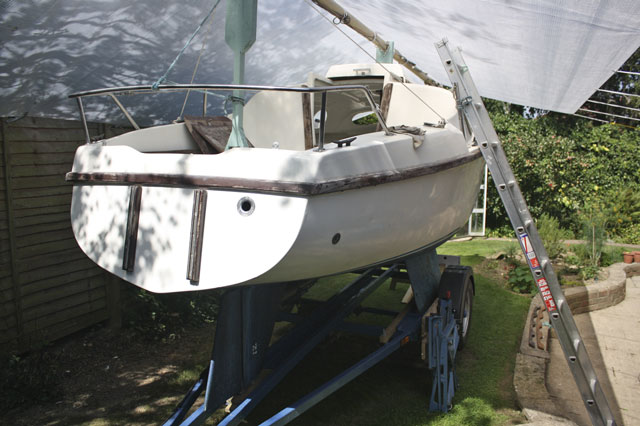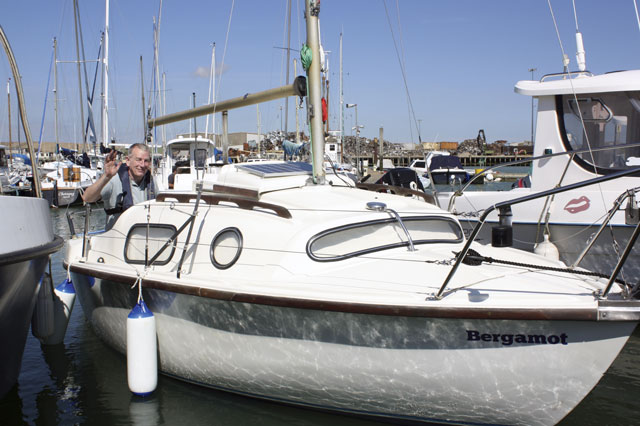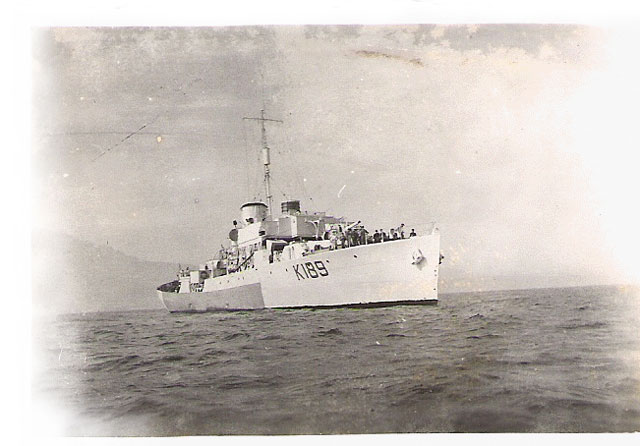John MacKenzie renovates a Leisure 17 that had lain unused in a field for nearly two decades
My father served aboard HMS Bergamot in the Second World War. Bergamot was a Flower Class corvette, a similar class of vessel to that on which the classic book and film The Cruel Sea was set. My father took part in escorting convoys to the Arctic to support the Russian forces.
After he passed away, I was doing some research to find out more about my father’s experiences during the war, and in due course, I stumbled upon an obscure internet forum which included some discussion about corvettes.
Soon I was sharing remembered stories with the son of another Bergamot crew member, when up popped a man called Alan with first-hand memories of Bergamot, asking to be put in touch with other crew members.
Alan is in his 90s and has the memory of an elephant, recounting stories and anecdotes of life on board HMS Bergamot and much more. He has become a very good friend: I treasure his enthusiastic and positive attitude to life, and despite his clear recollections of HMS Bergamot all those years ago he certainly does not live in the past, and has a very modern outlook.
Alan mentioned that he had sailed a small Leisure 17 cruiser for many years in the Solent. As a lifelong dinghy sailor this rekindled my hankering for a small boat with a lid on it, so I was interested in his opinions on his elderly, diminutive craft. He enthused that she had no foibles, and that he and his family had thoroughly enjoyed sailing her.
He then mentioned that he still had her under a cover on his rural smallholding in Hampshire, where she had been languishing for the past 17 years: if I was interested, he would be happy for me to ‘take her away’.
I conducted some research on the Leisure 17 and found much praise for this attractive little vessel, and even an account of an eventful transatlantic crossing by John Adam in 1968: this ended in his imprisonment in Cuba as a spy, as the Cubans did not believe such a small boat could successfully cross the Atlantic.
The Leisure Owners Association was very friendly and helpful and supplied a wealth of useful information which confirmed that Leisure 17s, despite their age, are solid, well-built basic boats with a very active and enthusiastic following. I was hooked. But what condition was she in?
A very sad old lady
After a 140-mile round trip with perfect directions from Alan (apart from a long-gone Little Chef), and with his permission to come aboard, I found myself in a field full of chest-high nettles in an idyllic spot in rural Hampshire.
When I hacked my way to the boat with a machete I found a very sad old lady full of water and covered in moss, tilting off her trailer as the rabbits had undermined the trailer supports – and there was more rust than trailer.
As for the cover, that had been half off for some time, the wind having whipped it up and scraped several arcs in the moss, lichen and the gelcoat of the hull.
I like a challenge, but I have to admit to having serious doubts at that point. However, it was a lovely sunny day, and things always look better in the sun. After a thorough inspection, I managed to convince myself – with a little imagination – that she was basically sound and could be nurtured back to life.
I accepted Alan’s kind offer – or should that be his challenge?
Shortly after seeing the boat I visited Alan at his home near Lymington, armed with a bottle of his favourite single malt whisky and some chocolates for his lovely wife Jean.
Alan helped me load the car with sails, cushions, an aged Evinrude 6hp two-stroke outboard and various other boat bits and pieces. Alan is as fit as a fiddle!
Jean confided to me that Alan was delighted that his beloved little boat was to be renovated and put back on the water again, where she belongs.
I now needed to get the boat back home, some 70 miles away, but first I needed somewhere to put her. This entailed replacing part of a fence with hinged panels, moving a shed on rollers (like the Egyptians building the pyramids) on to its new base, felling a tree and removing its root stump, and levelling the ground to a gentle incline – phew!
Now I had a boatyard with access ready for my little cruiser.

After a thorough renovation including new wheels, tyres and brakes, the trailer was modified with a bow support, docking arms and a winch
My next job was to get the boat off her trailer. With dozens of concrete blocks and substantial timbers on Alan’s smallholding, plus my three-ton trolley jack, I eventually managed to extricate the trailer from under the boat single-handed.
After fitting new wheels and tyres, and re-greasing the bearings and hitch, I cautiously towed the remains of the trailer home for a strip-down and rebuild with new brake parts, lots of DIY MIG welding, a couple of new additional spars and a new paint job.
The trailer has been modified with a bow support, docking arms and a winch so that I now tow her bow-first: the original set-up was stern-first, which other owners have advised me makes for tricky launches and recoveries.
A blank canvas
Having carefully eased her back on to her now shiny and renovated trailer (again single-handed), I gingerly towed the sad old girl back to my new boatyard and set about her restoration.
She was a very basic boat with no electrics, instruments etc, but having had only two owners she was pretty much a blank canvas for me to work on, albeit a tired one.
A quick pressure-wash removed a lot of the moss and lichen, and she started to look a bit more shipshape. With a big pot of elbow grease and abrasive pads the teak woodwork came up surprisingly well, and with new washboards she started to look quite smart.
The milky windows were removed and treated with mild rubbing compound: they polished up to a surprisingly high standard, which avoided my having to replace them.
The window seals had become very brittle and cracked so I replaced them all with new seals and a chrome-effect infill to brighten her up a bit – very ‘blingy’.
The interior had become home to several small animals and needed a complete clean-out and repaint: it is now fresh and bright.
Much of the internal woodwork had suffered badly from the ingress of water over many years, but when it dried out most of it was salvageable. After stripping off all of what remained of the old varnish, and with the application of a few new coats, it came up looking good. All the deck fittings were removed and re-seated to make her dry inside.
The mast had been resting low down on the trailer and had become home to many generations of mice: the whole length was packed with chewed-up halyard to make cosy nesting material. Strangely, the mice had only chewed one halyard so I was left with an aptly named ‘mouse-line’ for re-threading the new halyards. The pressure-washer soon removed the remaining detritus.
The boat had many layers of now crazed antifouling paint which had set rock-hard. I am sure that the laborious job of removing it will resonate with many readers as one of the worst jobs of a renovation.
However, a cheap electric scraper greatly speeded up the process, and as the boat was only 4.3m (14ft) at the waterline I could at least see the light at the end of the tunnel.
Her keels were in a sorry state, with much rust and several deep pits that needed to be primed and filled after being ground back to solid iron.
Her topsides are in her original gelcoat, which is not perfect: but with some cutting back and polishing she now looks presentable.
In my enthusiasm I added navigation lights, a depth sounder, a fixed radio and mast top antenna and a small GPS to link to the DSC radio to get her seaworthy. In fact she is probably far more seaworthy than I was as my previous sailing experience was dinghy sailing on inland waters, but I wanted her to be right.
I mounted the instruments on a hinged panel to the side of the companionway rather than mounting them in the cockpit to avoid making holes.
An unexpected bonus from the lack of fixed instruments is that this preserves that area as backrests for comfortable stretching out on lazy summer days.
The original method of attaching the mainsail was by a boltrope up the mast slot: this was very stiff, even after cleaning and treating with PTFE, so to make raising and lowering the main a much easier and safer task I have fitted nylon sliders, which work well.
My wife Sara has flashbacks about standing in windswept dinghies clutching wobbly masts while I attached the shrouds and stays, so I fabricated a method for single-handed raising and lowering of the mast.
I needed to replace the standing rigging as it appeared to be original, so I added moveable stainless steel straps to enable the lower shroud pivot points to line up with the mast base, providing lateral support when raising and lowering the mast without exerting strain.
It works very efficiently, and was relatively easy once I had worked out the required lengths with a bit of schoolboy trigonometry and line-of-sight checks. Fellow boaters are of course always prepared to lend a hand, so I could probably have done without this enhancement – but at least I know I can raise and lower the mast on my own without scaring Sara.

After a few modifications, John’s garden became a serviceable boatyard and work on the Leisure 17 proceeded in earnest
No foibles
The boat was launched from her trailer at Newhaven Marina without any problems on a sunny summer day in mid-July last year, having taken a year to renovate. (I just have to keep an eye open for the 143m ferry that creeps up behind the breakwater and past the marina to her berth.)
Two months of enjoyable sea trials followed, undertaking some great cruises along the South Coast with the Seven Sisters chalk cliffs as our backdrop and a trolling line picking up mackerel for supper
as we went.
Alan’s statement that she had no foibles was spot-on, as she is very stable and sails well for such a small cruiser: I am looking forward to using her as much as possible and enhancing my seamanship.
The 1974 two-stroke Evinrude was soon replaced with a shiny new 5hp Mercury four-stroke long-shaft saildrive, which is excellent as it has extra thrust and the gear change on the front of the engine.
I could probably have managed quite well with a 4hp, but I tend to over-engineer most things!
My upgrades after initial sea trials include leading all the control lines (there aren’t many!) back to the cockpit and adding a triple rope clutch for the furler line, main halyard and topping lift.
The old hanked-on jib worked well, but I am all in favour of an easy life so I have renovated and installed an old furler that I found through the owners association and adapted the jib to fit it, which is as yet untried.
I found the original jib sheet clam-cleats awkward, so I have replaced them with new ones.
The original genoa cars were simple resinite O-rings with a thumbscrew mounted on now brittle plastic rails. The cars were fiddly to adjust and had quite a lot of friction, so I replaced these with alloy rails and adjustable genoa cars.
The original backstay split into two at about 1m up: being so low, it got in the way when controlling and lifting the outboard, so I fitted dual backstays for better access to the outboard at the risk of having more weight up top and increasing the windage.
Sara was very patient during the year-long renovation, for which I am very grateful, but at least she has known where I was – in the boatyard or the garage! She is also smitten with our new-to-us little cruiser: well, on very calm days!
Meanwhile, Alan was a guest at the Russian Embassy recently when he received the Ushakov Medal for his Arctic convoy duty on board HMS Bergamot. Alan said it was ‘a bit chilly’ on the Arctic convoys, but it was a dry cold so it wasn’t so bad: typical of him to find something positive!
And what did I name our boat? Why, Bergamot, of course, in tribute to Alan, my father Angus, Colin’s father, and all the brave crew of what Alan describes as ‘a happy and clean ship’.
Say hello if you are near Seaford Bay and spot sail number 1630. Fair winds!

John named his boat Bergamot in tribute to his father Angus, Alan and the other brave crew of his boat’s illustrious namesake
First published in PBO Aug 2015 issue
The hard sell…
Did you know that Practical Boat Owner magazine (out every 4 weeks) is the UK’s biggest selling boating magazine and has been ever since it was launched in 1967. We cover sail and power, paddle and scull, kite and foil… you name it we float it.
Subscribe, or make a gift for someone else, and you’ll always save at least 30% compared to newsstand prices.
See the latest PBO subscription deals on magazinesdirect.com












